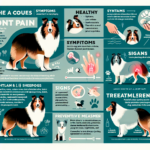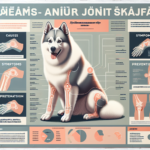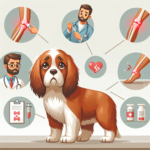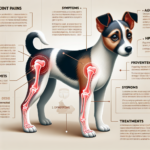Shetland Sheepdog Joint Pain: Causes, Symptoms, Prevention, and Treatment

Introduction
The Shetland Sheepdog, affectionately known as the Sheltie, is a small to medium-sized herding dog that originated in the Shetland Islands of Scotland. Known for their intelligence, agility, and striking resemblance to the Rough Collie, Shelties have been beloved companions and working dogs for centuries. Their keen herding instincts, combined with their loyal and affectionate nature, make them a popular choice for families and dog enthusiasts alike.
Like many purebred dogs, Shetland Sheepdogs are prone to certain health issues. Among these, joint pain is a significant concern that can affect their quality of life. Joint pain in Shelties can stem from various causes, including genetic predispositions, age-related wear and tear, and the physical demands of their active lifestyle. Understanding the causes, symptoms, prevention, and treatment of joint pain in Shelties is crucial for ensuring their long-term health and well-being.
Breed-Specific Joint Pain Risks
Genetic Predisposition
Shetland Sheepdogs are genetically predisposed to several joint-related issues, including hip dysplasia, elbow dysplasia, and arthritis. Hip dysplasia is a condition where the hip joint does not fit properly into the hip socket, leading to pain and mobility issues. Elbow dysplasia involves abnormal development of the elbow joint, causing lameness and discomfort. Arthritis, a degenerative joint disease, can also develop as a result of these conditions or independently as the dog ages.
Age-Related Risks
As Shelties age, the risk of developing joint pain increases. The wear and tear on their joints over the years can lead to conditions like osteoarthritis. Typically, signs of joint pain may start to appear in middle-aged Shelties, around 6-8 years old, but can occur earlier or later depending on the individual dog and its genetic makeup.
Activity Level and Joint Stress
Shetland Sheepdogs are known for their high energy levels and agility. They excel in activities such as herding, agility competitions, and obedience training. While regular exercise is essential for their overall health, excessive or high-impact activities can put additional stress on their joints, potentially leading to joint pain and injuries. It is important to balance their activity levels to prevent overexertion and joint damage.
Common Symptoms of Joint Pain in Shetland Sheepdogs
General Symptoms
- Limping or favoring one leg
- Stiffness, especially after rest or exercise
- Reluctance to jump, climb stairs, or engage in physical activities
- Decreased activity level or lethargy
- Visible discomfort or pain when touched or moved
- Swelling or heat around the joints
Breed-Specific Symptoms
In Shelties, joint pain may manifest more prominently in their hind legs due to their predisposition to hip dysplasia. Owners may notice a “bunny hopping” gait or difficulty rising from a lying position. Additionally, Shelties may exhibit changes in behavior, such as increased irritability or withdrawal from social interactions, as a response to chronic pain.
When to Consult a Vet
If you observe any of the above symptoms in your Sheltie, it is important to consult a veterinarian promptly. Early diagnosis and intervention can help manage joint pain more effectively and prevent further deterioration. Regular veterinary check-ups are also essential for monitoring your dog’s joint health and catching any issues early on.
Preventive Measures for Joint Health
Exercise Recommendations
Regular, moderate exercise is crucial for maintaining joint health in Shelties. Activities such as walking, swimming, and controlled play can help keep their joints flexible and muscles strong without causing excessive stress. Avoid high-impact activities like jumping or running on hard surfaces, which can exacerbate joint issues. Tailor the exercise routine to your dog’s age, fitness level, and any existing joint conditions.
Dietary Suggestions
A balanced diet rich in essential nutrients can support joint health in Shelties. Consider incorporating foods or supplements that contain glucosamine, chondroitin, and omega-3 fatty acids, which are known to promote joint health and reduce inflammation. Consult your veterinarian for specific dietary recommendations and appropriate dosages for your dog.
Weight Management
Maintaining a healthy weight is critical for reducing joint stress in Shelties. Excess weight can exacerbate joint pain and lead to further complications. Monitor your dog’s weight regularly and adjust their diet and exercise routine as needed to keep them at an optimal weight. Your veterinarian can provide guidance on the ideal weight range for your Sheltie and help develop a weight management plan if necessary.
Early Screening and Monitoring
Early screening for joint issues can help identify potential problems before they become severe. Regular veterinary check-ups should include joint assessments, especially as your Sheltie ages. X-rays and other diagnostic tests can be used to detect conditions like hip dysplasia or arthritis early on. Early intervention and treatment can significantly improve your dog’s quality of life and prevent further joint damage.
Treatment Options for Joint Pain
Non-Surgical Treatments
Non-surgical treatments for joint pain in Shelties include medications, physical therapy, and lifestyle adjustments. Anti-inflammatory drugs and pain relievers can help manage pain and reduce inflammation. Physical therapy, including exercises and massage, can improve joint mobility and strengthen supporting muscles. Lifestyle adjustments, such as providing a comfortable bed and avoiding high-impact activities, can also alleviate joint pain.
Surgical Options
In severe cases of joint pain, surgical intervention may be necessary. Common surgical options for Shelties include hip replacement, arthroscopy, and joint fusion. Hip replacement involves replacing the damaged hip joint with an artificial one, while arthroscopy is a minimally invasive procedure used to diagnose and treat joint issues. Joint fusion, or arthrodesis, involves fusing the bones in a joint to eliminate pain. Your veterinarian will determine the most appropriate surgical option based on your dog’s specific condition and overall health.
Alternative Therapies
Alternative therapies can complement traditional treatments and provide additional relief for joint pain. Acupuncture, hydrotherapy, and massage are popular options that can help reduce pain and improve joint function. Acupuncture involves inserting thin needles into specific points on the body to stimulate healing, while hydrotherapy uses water resistance to support gentle exercise. Massage can help relax muscles and improve circulation around the joints. Consult your veterinarian before starting any alternative therapies to ensure they are safe and appropriate for your Sheltie.
Lifestyle and Management Tips
Daily Care Routine
A consistent daily care routine can help manage and alleviate joint pain in Shelties. Start with a gentle morning walk to loosen stiff joints, followed by a balanced meal with joint-supporting supplements. Incorporate short, low-impact play sessions throughout the day to keep your dog active without overexerting their joints. End the day with a relaxing massage or gentle stretching exercises to promote flexibility and reduce discomfort.
Modifying the Home Environment
Making your home more comfortable for a dog with joint pain can significantly improve their quality of life. Consider adding ramps or steps to help your Sheltie access furniture or climb stairs without jumping. Provide an orthopedic bed with ample cushioning to support their joints while resting. Ensure that food and water bowls are at a comfortable height to reduce strain on their neck and joints.
Long-Term Management
Long-term management of joint pain in Shelties involves a combination of regular veterinary care, appropriate exercise, a balanced diet, and a supportive home environment. Monitor your dog’s condition closely and adjust their care routine as needed to accommodate changes in their joint health. Stay proactive in addressing any new symptoms or concerns, and work closely with your veterinarian to develop a comprehensive management plan tailored to your dog’s needs.
FAQs About Shetland Sheepdogs and Joint Pain
What are the early signs of joint pain in Shelties?
Early signs of joint pain in Shelties include limping, stiffness, reluctance to move or jump, and visible discomfort when touched or moved. If you notice any of these symptoms, consult your veterinarian for a thorough evaluation.
Can joint pain in Shelties be prevented?
While genetic predispositions cannot be entirely prevented, you can take steps to reduce the risk of joint pain in Shelties. Maintain a healthy weight, provide regular, moderate exercise, and ensure a balanced diet with joint-supporting nutrients. Early screening and monitoring can also help catch potential issues before they become severe.
Are there specific exercises that are better for Shelties with joint pain?
Low-impact exercises such as walking, swimming, and controlled play are ideal for Shelties with joint pain. Avoid high-impact activities like jumping or running on hard surfaces, which can exacerbate joint issues. Tailor the exercise routine to your dog’s age, fitness level, and any existing joint conditions.
What dietary supplements can help support joint health in Shelties?
Supplements containing glucosamine, chondroitin, and omega-3 fatty acids can support joint health in Shelties. These nutrients help reduce inflammation, promote cartilage repair, and improve joint function. Consult your veterinarian for specific recommendations and appropriate dosages for your dog.
When should I consider surgical options for my Sheltie’s joint pain?
Surgical options should be considered when non-surgical treatments are no longer effective in managing your Sheltie’s joint pain, and the condition significantly impacts their quality of life. Your veterinarian will determine the most appropriate surgical option based on your dog’s specific condition and overall health.
Conclusion
Joint pain is a common concern for Shetland Sheepdogs, but with proper care and attention, it can be managed effectively. Understanding the causes, symptoms, prevention, and treatment options for joint pain in Shelties is essential for ensuring their long-term health and well-being. By taking preventive measures, providing appropriate exercise and nutrition, and working closely with your veterinarian, you can help your Sheltie lead a happy, active life despite joint pain.
Remember to monitor your dog’s condition regularly, make necessary adjustments to their care routine, and consult your veterinarian for any concerns. With the right approach, you can support your Sheltie’s joint health and enhance their overall quality of life.




